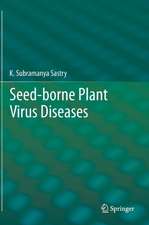Astrovirus Research: Essential Ideas, Everyday Impacts, Future Directions
Editat de Stacey Schultz-Cherryen Limba Engleză Paperback – 9 noi 2014
| Toate formatele și edițiile | Preț | Express |
|---|---|---|
| Paperback (1) | 1088.96 lei 6-8 săpt. | |
| Springer – 9 noi 2014 | 1088.96 lei 6-8 săpt. | |
| Hardback (1) | 1095.90 lei 6-8 săpt. | |
| Springer – 12 oct 2012 | 1095.90 lei 6-8 săpt. |
Preț: 1088.96 lei
Preț vechi: 1146.26 lei
-5% Nou
Puncte Express: 1633
Preț estimativ în valută:
208.38€ • 222.82$ • 173.74£
208.38€ • 222.82$ • 173.74£
Carte tipărită la comandă
Livrare economică 17 aprilie-01 mai
Preluare comenzi: 021 569.72.76
Specificații
ISBN-13: 9781489994066
ISBN-10: 1489994068
Pagini: 200
Ilustrații: XIV, 186 p.
Dimensiuni: 155 x 235 x 11 mm
Greutate: 0.29 kg
Ediția:2013
Editura: Springer
Colecția Springer
Locul publicării:New York, NY, United States
ISBN-10: 1489994068
Pagini: 200
Ilustrații: XIV, 186 p.
Dimensiuni: 155 x 235 x 11 mm
Greutate: 0.29 kg
Ediția:2013
Editura: Springer
Colecția Springer
Locul publicării:New York, NY, United States
Public țintă
ResearchCuprins
Preface.- Epidemiology of Human Astroviruses.- Replication Cycle of Astroviruses.- Astrovirus Structure and Assembly.- Astrovirus Pathogenesis.- Immune Responses.- Astrovirus Taxonomy.- New Human Astroviruses.- Astrovirus Infections in Animal Mammalian Species.- Avian Astroviruses.- Index.
Textul de pe ultima copertă
Since their initial discovery in the 1970’s, astroviruses have been recognized as a leading cause of enteritis in infants, the elderly, and immunocompromised people, and were known to be widespread in animals and birds. In recent years, and with the advent of pyrosequencing, there has been a virtual explosion in the number of newly identified astrovirus genotypes. With this has come an increased understanding in astrovirus biology, structure, epidemiology, immunology, and disease pathogenesis including the likelihood of extraintestinal and systemic infections. The advent of new diagnostic tests that detect all of the currently identify human astrovirus strains may prove that these viruses are more prevalent in populations than currently realized.
This book will provide state-of-the-art information on our current understanding of astroviruses for researchers, medical and veterinary providers, and diagnosticians as prepared by the leaders in the respective fields. The goal is to bring the reader up to date on the state of knowledge on this constantly evolving and exciting field of virology.
This book will provide state-of-the-art information on our current understanding of astroviruses for researchers, medical and veterinary providers, and diagnosticians as prepared by the leaders in the respective fields. The goal is to bring the reader up to date on the state of knowledge on this constantly evolving and exciting field of virology.
Caracteristici
First book of its kind Would remain up-to-date for 3-5 years Will be of great interest to professionals and researchers from many different fields, including public health and food safety experts, poultry specialists, microbiologists, virologists, pediatricians, and veterinarians? Includes supplementary material: sn.pub/extras




